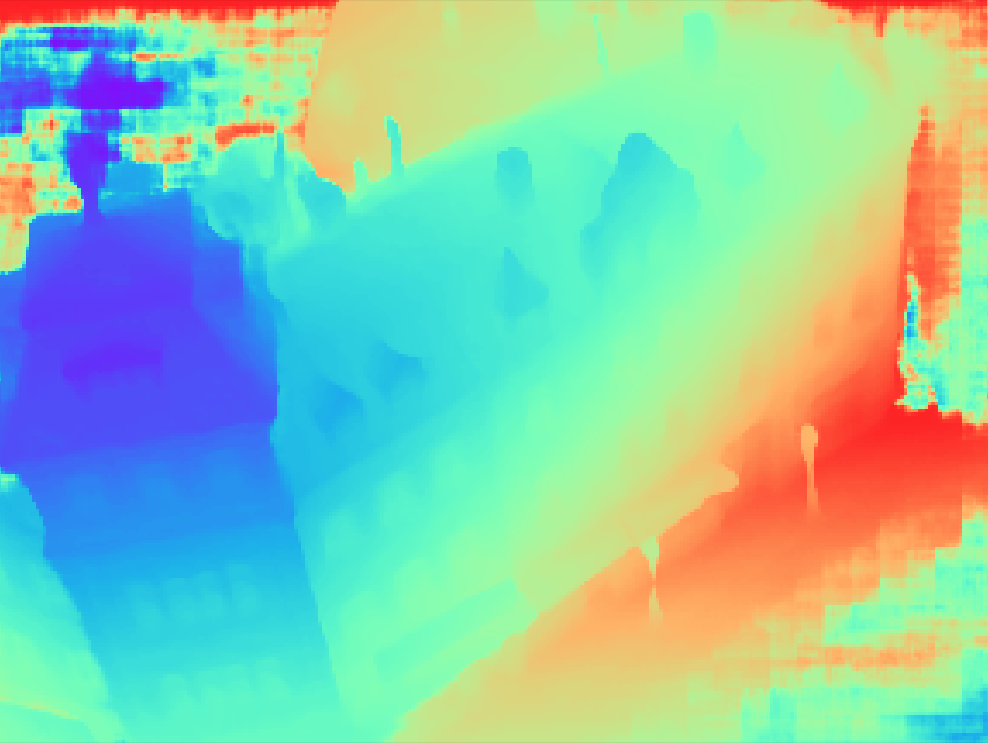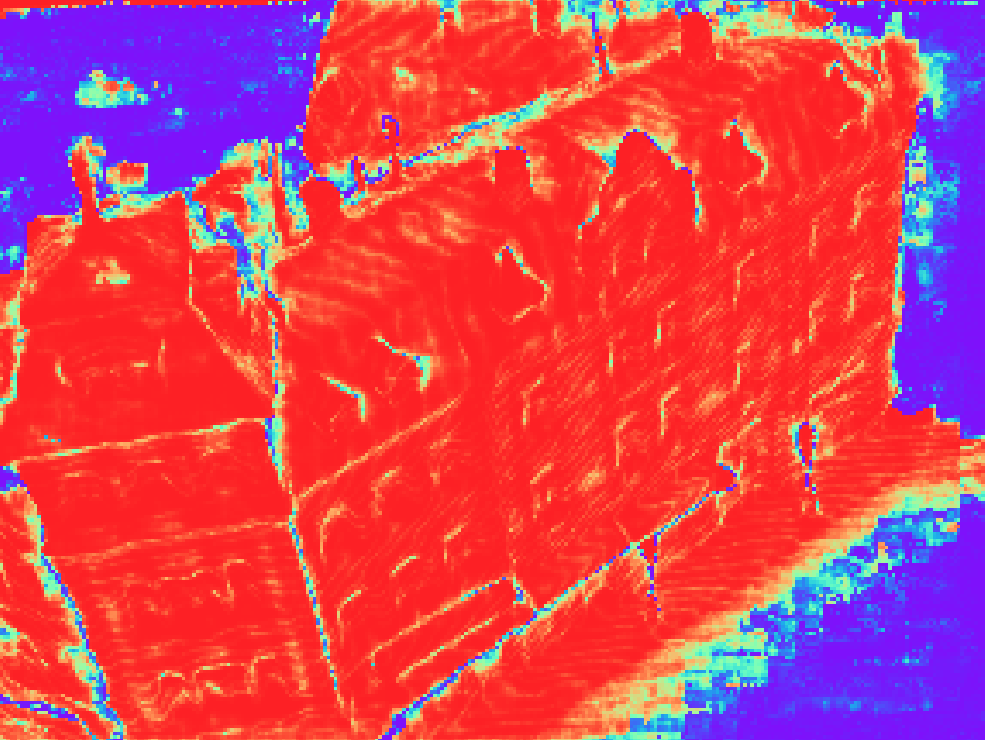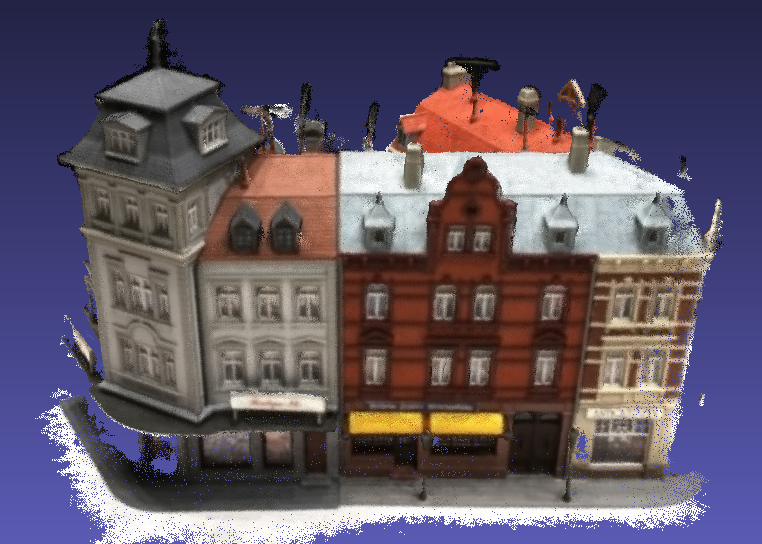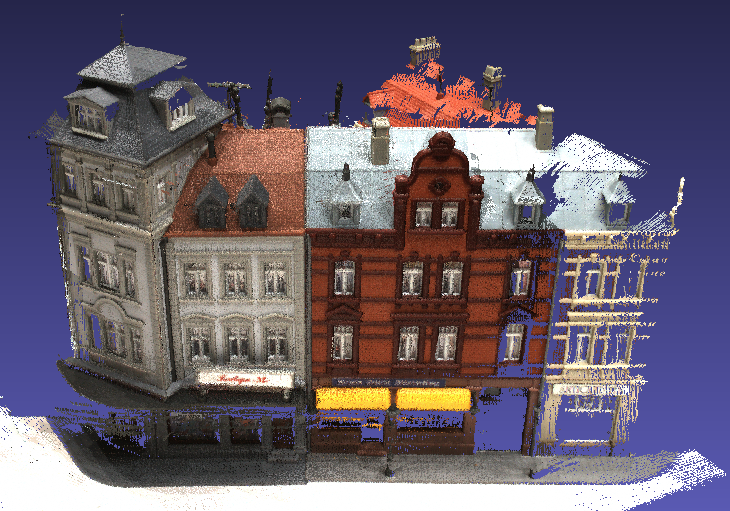- Clone the repo
- Install gcloud command line tools
export JOB_NAME=your-unique-job-name
gcloud ml-engine jobs submit training $JOB_NAME \
--job-dir gs://mvs-training-mlengine/$JOB_NAME \
--module-name mvsnet.train \
--package-path /Users/chrisheinrich/ml/MVSNet/mvsnet \
--region us-central1 \
--runtime-version 1.13 \
--config /Users/chrisheinrich/ml/MVSNet/machines/1p100.yaml \
-- \
--train_data_root gs://mvs-training-mlengine/dtu_7scenes_rgbd_scenes11_fixed/ \
--log_dir gs://mvs-training-mlengine/$JOB_NAME/logs/ \
--model_dir gs://mvs-training-mlengine/$JOB_NAME/models \
--epoch 1 \
--num_gpus 1
This command would train MVSNet for 1 epochs on a dataset of consisting of DTU, scenes11, RGBD and 7 Scenes on a p100 GPU.
You can convert Atlas data into the format read by MVSNet for inference using the following command:
bzr ubq/ai/tools:map-to-mvs-training -- --map-id <atlas-map-id> --stack <stack> --data-dir <dir-to-deposit-data>
Which would download a map from Atlas and then conver to the right format. Then you can do inference on that data by running this command from the root of the mvsnet repo
python -m mvsnet.inference --input_dir <atlas-data-in-densify-train-format> --ckpt_step <ckpt-of-saved-model> --model_dir <dir-where-saved-model-is>
Note that --model_dir can be a google storage bucket where models were saved during training with ml-engine, so you could run:
python -m mvsnet.inference --input_dir <atlas-data-in-densify-train-format> --ckpt_step 35000 --model_dir gs://mvs-training-mlengine/dtu_scan_104_epochs_200_lr_0025_viewnum_4/models/
To use one of our trained models trained for 35000 steps
The library we use to fuse MVSNet depth maps (fusibile - https://github.com/kysucix/fusibile ), requires a GPU to run, so if you want to use it you will need to connect to a GPU box. One that you can use, which already has fusibile installed, is a google cloud box named deepmvs-vm. To connect to this you will need the gcloud command line tools. Next, you can run:
gcloud compute instances start deepmvs-vm # starts the instance
gcloud compute ssh deepmvs-vm --zone us-west1-b # connects to the instance
cd MVSNet
nohup python -m scripts.test_and_fuse --ckpt_step 1350000 --model_dir ./model --prob_threshold 0.1 --disp_threshold 0.2 --num_consistent 3 --test_folder_root /home/chrisheinrich/data/atlas2/ --no_test &
This woud run our test_and_fuse script which performs inference on all of the Atlas test data we have on that machine (you could add more), fuses the depth maps, and then uploads the results to sketchfab. At the end of all this you can run:
cat nohup.out
to view the output, the last few lines of which will contain the URLs of the uploaded PLYs on sketchfab. The prob_threshold and disp_threshold are arguments passed to fusibile for point cloud fusion. Heuristically speaking:
- Higher prob_threshold leads to higher precision and lower recall
- Lower disp_threshold leads to higher precision and lower recall
- Higher num_consistent leads to higher precision and lower recall
or vice versa.
MVSNet is a deep learning architecture for depth map inference from unstructured multi-view images, and R-MVSNet is its extension for scalable learning-based MVS reconstruction. If you find this project useful for your research, please cite:
@article{yao2018mvsnet,
title={MVSNet: Depth Inference for Unstructured Multi-view Stereo},
author={Yao, Yao and Luo, Zixin and Li, Shiwei and Fang, Tian and Quan, Long},
journal={European Conference on Computer Vision (ECCV)},
year={2018}
}
@article{yao2019recurrent,
title={Recurrent MVSNet for High-resolution Multi-view Stereo Depth Inference},
author={Yao, Yao and Luo, Zixin and Li, Shiwei and Shen, Tianwei and Fang, Tian and Quan, Long},
journal={Computer Vision and Pattern Recognition (CVPR)},
year={2019}
}
- Check out the source code
git clone https://github.com/YoYo000/MVSNet - Install cuda 9.0, cudnn 7.0 and python 2.7
- Install Tensorflow and other dependencies by
sudo pip install -r requirements.txt
- Download the preprocessed DTU training data (Fixed training cameras, Sep. 19), and upzip it as the
MVS_TRANINGfolder - Enter the
MVSNet/mvsnetfolder, intrain.py, setdtu_data_rootto yourMVS_TRANINGpath - Create a log folder and a model folder in wherever you like to save the training outputs. Set the
log_dirandsave_dirintrain.pycorrespondingly - Train MVSNet (GTX1080Ti):
python train.py --regularization 'GRU' - Train R-MVSNet (GTX1080Ti):
python train.py --regularization '3DCNN'
- Download the test data for scan9 and unzip it as the
TEST_DATA_FOLDERfolder, which should contain onecamsfolder, oneimagesfolder and onepair.txtfile - Download the pre-trained MVSNet and R-MVSNet models and upzip the file as
MODEL_FOLDER - Enter the
MVSNet/mvsnetfolder, intest.py, setmodel_dirtoMODEL_FOLDER - Run MVSNet (GTX1080Ti):
python test.py --dense_folder TEST_DATA_FOLDER --regularization '3DCNN' --width 1152 --height 864 --max_d 192 --interval_scale 1.06 - Run R-MVSNet (GTX1080Ti):
python test.py --dense_folder TEST_DATA_FOLDER --regularization 'GRU' --width 1600 --height 1200 --max_d 256 --interval_scale 0.8 - Inspect the .pfm format outputs in
TEST_DATA_FOLDER/depths_mvsnetusingpython visualize.py .pfm. For example the depth map and probability map for image00000012should be something like:
 |
 |
 |
|---|---|---|
| reference image | depth map | probability map |
R/MVSNet itself only produces per-view depth maps. To generate the 3D point cloud, we need to apply depth map filter/fusion for post-processing. As our implementation of this part is depended on the Altizure internal library, currently we could not provide the corresponding code. Fortunately, depth map filter/fusion is a general step in MVS reconstruction, and there are similar implementations in other open-source MVS algorithms. We provide the script depthfusion.py to utilize fusibile for post-processing (thank Silvano Galliani for the excellent code!).
To run the post-processing:
- Check out the modified version fusibile
git clone https://github.com/YoYo000/fusibile - Install fusibile by
cmake .andmake, which will generate the executable atFUSIBILE_EXE_PATH - Run post-processing (--prob_threshold 0.8 if using 3DCNN):
python depthfusion.py --dense_folder TEST_DATA_FOLDER --fusibile_exe_path FUSIBILE_EXE_PATH --prob_threshold 0.3 - The final point cloud is stored in
TEST_DATA_FOLDER/points_mvsnet/consistencyCheck-TIME/final3d_model.ply.
We observe that the point cloud output of depthfusion.py is very similar to our own implementation. For detailed differences, please refer to MVSNet paper and Galliani's paper. The point cloud for scan9 should look like:
 |
 |
|---|---|
| point cloud result | ground truth point cloud |
The following steps are required to reproduce the point cloud results:
- Generate R/MVSNet inputs from the SfM outputs, you can use our preprocessed inputs for DTU, Tanks and Temples and ETH3D datasets (provided)
- Run R/MVSNet test script to generate depth maps for all views (provided)
- Apply variational depth map refinement for all views (optional, not provided)
- Apply depth map filter and fusion to generate the point cloud results (partially provided via fusibile)
R-MVSNet point cloud results with full post-processing are also provided: DTU evaluation point clouds
Each project folder should contain the following
.
├── images
│ ├── 00000000.jpg
│ ├── 00000001.jpg
│ └── ...
├── cams
│ ├── 00000000_cam.txt
│ ├── 00000001_cam.txt
│ └── ...
└── pair.txt
If you want to apply R/MVSNet to your own data, please structure your data into such a folder.
All image files are stored in the images folder. We index each image using an 8 digit number starting from 00000000. The following camera and output files use the same indexes as well.
The camera parameter of one image is stored in a cam.txt file. The text file contains the camera extrinsic E = [R|t], intrinsic K and the depth range:
extrinsic
E00 E01 E02 E03
E10 E11 E12 E13
E20 E21 E22 E23
E30 E31 E32 E33
intrinsic
K00 K01 K02
K10 K11 K12
K20 K21 K22
DEPTH_MIN DEPTH_INTERVAL (DEPTH_NUM DEPTH_MAX)
Note that the depth range and depth resolution are determined by the minimum depth DEPTH_MIN, the interval between two depth samples DEPTH_INTERVAL, and also the depth sample number DEPTH_NUM (or max_d in the training/testing scripts if DEPTH_NUM is not provided). We also left the interval_scale for controlling the depth resolution. The maximum depth is then computed as:
DEPTH_MAX = DEPTH_MIN + (interval_scale * DEPTH_INTERVAL) * (max_d - 1)
We store the view selection result in the pair.txt. For each reference image, we calculate its view selection scores with each of the other views, and store the 10 best views in the pair.txt file:
TOTAL_IMAGE_NUM
IMAGE_ID0 # index of reference image 0
10 ID0 SCORE0 ID1 SCORE1 ... # 10 best source images for reference image 0
IMAGE_ID1 # index of reference image 1
10 ID0 SCORE0 ID1 SCORE1 ... # 10 best source images for reference image 1
...
The test.py script will create a depths_mvsnet folder to store the running results, including the depth maps, probability maps, scaled/cropped images and the corresponding cameras. The depth and probability maps are stored in .pfm format. We provide the python IO for pfm files in the preprocess.py script, and for the c++ IO, we refer users to the Cimg library. To inspect the pfm format results, you can simply type python visualize.py .pfm.
- Validation script
- View selection from Altizure/COLMAP/OpenMVG SfM output
- Depth sample selection from Altizure/COLMAP/OpenMVG SfM output
- Use
tf.contrib.image.transformfor differentiable homography warping. Reconstruction is now x2 faster!
- Implement R-MVSNet and GRU regularization
- Network change: enable scale and center in batch normalization
- Network change: replace UniNet with 2D UNet
- Network change: use group normalization in R-MVSNet
- MVSNet / R-MVSNet and training / testing scripts
- MVSNet and R-MVSNet models (trained for 100000 iterations)
- Add "Reproduce Benchmarking Results" section
- Add R-MVSNet point clouds of DTU evaluation set